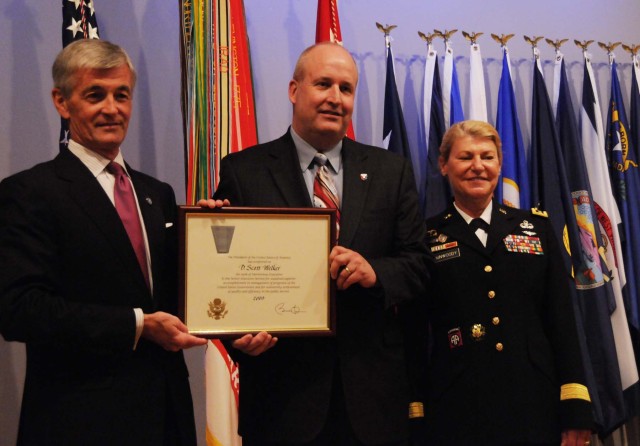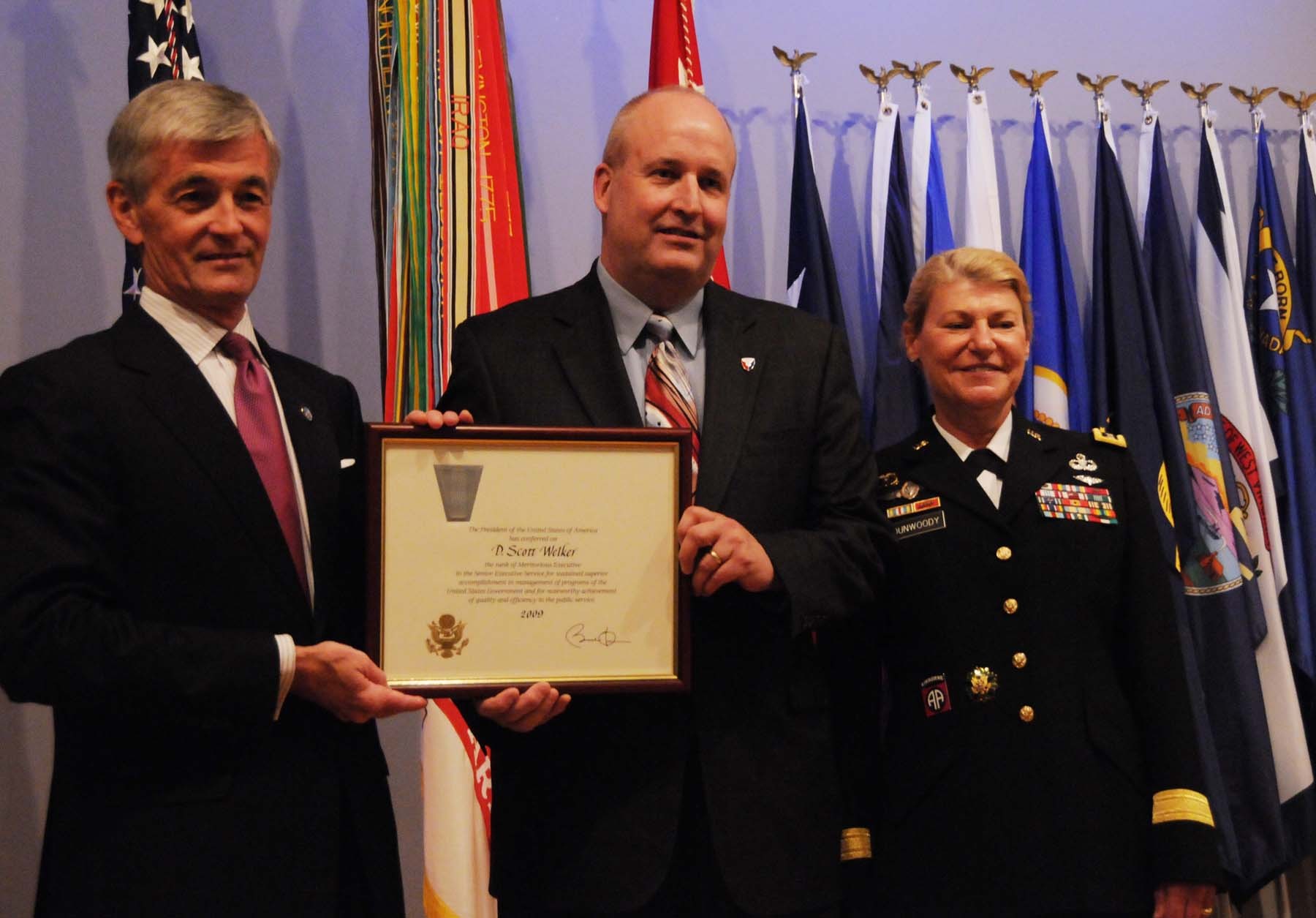ARLINGTON, Va. -- The Secretary of the Army John McHugh presented awards to eleven U.S. Army Materiel Command senior professionals in a special recognition ceremony held at the Women's Memorial at Arlington Cemetery June 28.
Two of the award winners received the Distinguished Executive Rank Award, six received the Meritorious Executive Rank Award, two received the Distinguished Senior Professional Rank Award and one received the Meritorious Senior Professional Rank Award.
Awardees are nominated by the Secretary of the Army, evaluated by boards of private citizens, and approved by the President. The evaluation criteria focus on the executive's leadership in producing results. The Presidential Rank Award is the most prestigious recognition given to career executives and senior professionals, according to the U.S. Office of Personnel Management.
The 2009 AMC award winners include:
Distinguished Executive Rank
Dr. Joseph A. Lannon
U.S. Army Armament Research, Development, and Engineering Center
Dr. Joseph Lannon manages more than 3,000 people, 64 laboratories, 800 buildings, a budget of $1 billion, and the technology and products related to the Army's suite of guns from the smallest calibers to artillery, including gun fire control. During Dr. Lannon's tenure, he managed, designed and fielded hundreds of armaments and achieved a center-wide cost savings of $100 million and cost avoidance of $4 billion.
John L. Shipley
U.S. Army Aviation and Missile Life Cycle Management Command
John Shipley is responsible for the development, acquisition, modernization, and fielding of the
U.S. Army Special Operations' aviation fleet. Shipley's technical expertise,
operational knowledge, management skills, and persistence in streamlining acquisition has provided capability for Special Operations Forces to strike in the most extreme operating environments.
Meritorious Executive Rank
Kathryn Condon
Headquarters, U.S. Army Materiel Command (formerly)
Kathryn Condon developed a human capital strategy to lead AMC through the most complicated and extensive base realignment and closure efforts the Department of the Army has encountered. Due to her efforts, AMC become the leader in the BRAC initiative throughout the Army. The Secretary of the Army selected Condon to co-lead the Army Contracting Task Force to look at current Army operations and future plans for providing contracting support to contingency or other Army operations. Under her leadership, the review of contracting support in Kuwait produced a cost avoidance of more than $14 million and a cost savings of approximately $189 million for the Army. Her efforts led to the creation of the Army Contracting Command.
John P. Dugan
U.S. Army TACOM Life Cycle Management Command (formerly)
John Dugan led the successful fielding of more than 29,000 tactical wheeled vehicles, returning more than 45,000 pieces of Army equipment, including 800 combat vehicles, to optimal condition after redeployment. Using the discipline and continuous improvement philosophy of Lean Six Sigma, Dugan reduced redundant operations, and improved the quality and timeliness of products while reducing direct costs and overhead. His efforts to inculcate Lean Six Sigma into every business aspect within TACOM LCMC garnered more than $125 million in validated cost savings/avoidance during fiscal year 2008 alone.
Anthony Lisuzzo
U.S. Army Communications-Electronics Command
Anthony Lisuzzo's efforts resulted in delivery of 23 different intelligence and electronic warfare systems to Operation Iraqi Freedom and Operation Enduring Freedom, including the fielding of more than 30,000 crucial electronic countermeasure systems to protect Soldiers against Improvised Explosive Devices. Lisuzzo is a leader in the cyber warfare arena in the areas of basic research, vulnerability assessments, technical test and prototyping, and satisfying real world operational requirements for Joint and U.S. Army asymmetric warfare operations efforts worldwide.
Thomas M. Mathes
U.S. Army Tank Automotive Research, Development and Engineering Center
Thomas Mathes led multiple teams for TARDEC and partnered with non-government subject-matter experts in industry and academia to solve urgent problems facing Soldiers. Mathes led the development of the High Mobility Multipurpose Wheeled Vehicle (HMMWV) improvement program to enhance HMMWV survivability and performance challenges. Mathes is using this same successful strategy in the Fuel Efficient Ground Vehicle Demonstrator Program. He also directed the development of HMMWV Egress Assistance Trainer and Self Protective Adaptive Roller Kit systems. In June 2008, both programs received an Army's Greatest Invention award.
John M. Pellegrino
U.S. Army Research Laboratory
Dr. John Pellegrino is responsible for basic and applied research in the fields of electronics, sensors, and power and energy technologies, with an annual program budget in excess of $650 million, more than $400 million in capital assets, and a workforce of more than 350 civilian and military employees. He led the rapid transition of many technologies from the laboratory to the field, providing aerostat and airborne persistent surveillance sensors, unattended ground sensors for area monitoring and defense, and components to counter improvised explosive devices, providing lifesaving capability to Soldiers.
D. Scott Welker
U.S. Army Sustainment Command
D. Scott Welker was instrumental in developing and implementing systemic fixes across the Army and obtained incredibly successful results with the operations of the Left Behind Equipment program. Working with Forces Command, he led efforts to re-engineer the process for equipment lateral transfers that allowed the equipment to be fixed to standard and moved to the next deploying units. As part of the Unit Status Readiness report, Welker led the effort to get critical unit equipment requisitioned for brigades, increasing the percentage of equipment requisitioned from 18 percent to 84 percent in less than 6 months.
Distinguished Senior Professional Rank
Dr. Kwong-Kit Choi
U.S. Army Research Laboratory
Dr. Kwong-Kit Choi is the world authority on quantum well-infrared technology used in night vision, missile guidance, and projectile defense systems. He invented the quantum well-infrared photodetector that started a new technology revolution. As a result of Dr. Choi's efforts, quantum well-infrared photodetector sensors are now being deployed by militaries worldwide as the next generation of advanced infrared sensors and have also found uses in civilian applications. Dr. Choi further improved the technology by inventing the corrugated-quantum well-infrared photodetector sensor structure, yielding exceptional results in current missions. Because of Dr. Cho's creative, ingenious and diligent work, affordable and high performance cameras are now available to the scientific, medical and industrial communities for much wider applications, ultimately strengthening national security.
Dr. Mark B. Tischler
U.S. Army Research Development and Engineering Command
Dr. Mark Tischler is an internationally recognized technical expert and research leader in the field of rotorcraft flight dynamics and control, responsible for all planning and execution of the Army's $4.2 million flight control program on unmanned and manned rotorcraft. He led the development of key technologies that have fundamentally changed the way that rotorcraft control development is conducted. His integrated methods have greatly increased design and flight-test efficiency, and have been instrumental in achieving improvements to United States rotorcraft operational effectiveness in theater, especially in degraded weather conditions. He is heavily involved in the strategic planning of future Army aviation research programs, and is widely consulted on flight dynamics and control applications well beyond the rotorcraft field of discipline.
Meritorious Senior Professional Rank
Dr. James J. Valdes
U.S. Army Edgewood Chemical Biological Center
Dr. James Valdes has authored more than 120 scientific publications, many
of which represent seminal accomplishments in the field of biotechnology. Dr. Valdes was the first to develop receptor-based biosensors which mimicked human physiology, chairing the first
four international conferences in this emerging discipline. He led the development of novel hybrid, waste-to-energy technology which has been deployed in Iraq, reducing the military's need for petroleum based fuels. Dr. Valdes serves as the lead scientist on major Department of Defense initiatives in the area of abiotic systems, developing technology which has the functionality of living systems, and in transdisciplinary science, designing a $300 million strategic science program for the Defense Threat Reduction Agency.


Social Sharing